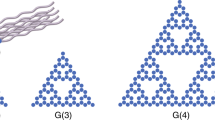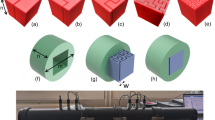Abstract
One of the simplest optical systems, consisting of two mirrors facing each other to form a resonator, turns out to have a surprising property. Stable resonators, in which the paths of the rays are confined between the two mirrors, have a well known mode structure (hermite–gaussian), but the nature of the modes that can occur in unstable reson-ant cavities (from which the rays ultimately escape) are harder to calculate, particularly for real three-dimensional situations1. Here we show that these peculiar eigenmodes of unstable resonators are fractals, a finding that may lead to a better understanding of phenomena such as chaotic scattering and pattern formation. Our discovery may have practical application to lasers based on unstable resonators1.
Similar content being viewed by others
Main
For a confocal unstable resonator consisting of a large concave mirror and a small convex feedback mirror sharing a common focus, the rays spill over the small mirror so that its size and shape define the output aperture (Fig. 1, insets); the other mirror is so large that its size and shape are irrelevant. The properties of an unstable resonator are determined by the round- trip magnification M and the (equivalent) Fresnel number N of the resonator: N≡(M−1)a2/2λL, where λ is the optical wavelength, 2a is the size of the small mirror, and L is the cavity length1. The existence of a round-trip magnification M is characteristic for unstable resonators, as stable resonators lack such magnification. The value of M determines the round-trip spill-over loss around the small mirror, and N controls the size of the smallest details in the transverse mode profile as determined by diffraction. In an unstable-cavity laser, the losses are compensated by the gain provided by the laser medium.
Free-space propagation of the optical field is described by the Huygens–Fresnel integral1, and cavity eigenmodes u(x,y) are defined by the requirement that, after one round trip, the field profile remains unchanged apart from a complex multiplier (the eigenvalue of the mode). We have calculated the mode patterns for a range of different aperture shapes, concentrating particularly on regular polygons and rhomboids. This calculation is numerically very demanding, so we used a non-orthogonal grid2 to increase efficiency. For square or circular apertures, the diffraction problem can be reduced to a one-dimensional calculation, with the mode patterns for the square factorizing into x and y components.
A typical modal intensity distribution for triangular aperturing is shown in Fig. 1. Smaller and smaller triangles keep appearing as the mode pattern is repeatedly magnified. This shows the self-similar nature of the mode, which continues down to the diffraction limit of approximately a/4N. On even smaller scales, further magnification does not reveal further substructure (Fig. 1, bottom). In the asymptotic limit λ↓0 (N→∞), the diffractive spreading becomes negligible, leading to an ideal fractal. Large-N resonators are feasible (for example, N=14 has already been realized in ref. 3).
The origin of the self-similarity can be understood intuitively: the existence of the round-trip magnification M means that the eigenmode must consist of (de)magnified copies of itself. Note that the hermite–gaussian modes of stable resonators are not self-similar because the round-trip magnification is absent.
A characteristic property of fractals is their non-integer fractal dimension Df (refs 4,5). We found that an accurate determination of Df for two-dimensional modes (as in Fig. 1) would require calculations at much higher N than considered here, and hence computational resources beyond those available; in earlier calculations6 for one-dimensional resonators with N=103, we found that Df was 1.6±0.1.
It has been shown that a tetraedical stacking of four reflecting spheres represents a chaotically scattering system with inherent fractal properties7. Our results help to explain this: light rays repeatedly scattering in the inner chamber of the tetraedical stacking undergo geometrical magnification owing to the reflecting spheres, just as in our unstable resonator. Coincidentally, the ‘aperture’ in ref. 7 is approximately triangular, like our aperture in Fig. 1, leading to similar patterns. The self-similar aspect seems to be a useful unifying feature of optical-pattern generation, providing insight into chaotic scattering7 and transverse nonlinear optics8. In the latter case, there is competition between bulk nonlinear behaviour and boundary-imposed linear diffraction as pattern-generating mechanisms.
References
Siegman, A. E. Lasers Ch. 19, 22 (University Science, Mill Valley, California, 1986).
McDonald, G. S. & Firth, W. J. J. Mod. Opt. 40, 23–32 (1993).
Cheng, Y.-J., Fanning, C. G. & Siegman, A. E. Phys. Rev. Lett. 77, 627–630 (1996).
Falconer, K. Fractal Geometry: Mathematical Foundations and Applications (Wiley, New York, 1990).
Peitgen, H.-O., Jürgens, H. & Saupe, D. Chaos and Fractals (Springer, New York, 1992).
Karman, G. P. & Woerdman, J. P. Opt. Lett. 23, 1909–1911 (1998).
Sweet, D., Ott, E. & Yorke, J. A. Nature 399, 315–316 (1999).
Lugiato, L. A., Brambilla, M. & Gatti, A. Adv. Atom. Mol. Opt. Phys. 40, 229–306 (1999).
Author information
Authors and Affiliations
Rights and permissions
About this article
Cite this article
Karman, G., McDonald, G., New, G. et al. Fractal modes in unstable resonators. Nature 402, 138 (1999). https://doi.org/10.1038/45960
Issue Date:
DOI: https://doi.org/10.1038/45960
This article is cited by
-
Graphene-integrated waveguides: Properties, preparation, and applications
Nano Research (2022)
-
Quantum transport in fractal networks
Nature Photonics (2021)
-
Fractal modes and multi-beam generation from hybrid microlaser resonators
Nature Communications (2018)
-
Fractal optics and beyond
Nature Photonics (2012)
-
Self-similarity in ultrafast nonlinear optics
Nature Physics (2007)
Comments
By submitting a comment you agree to abide by our Terms and Community Guidelines. If you find something abusive or that does not comply with our terms or guidelines please flag it as inappropriate.




